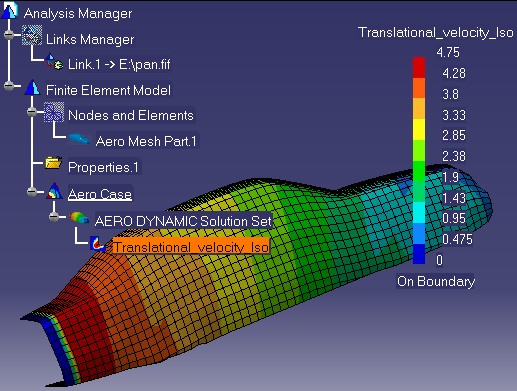
Analysis Solution |
Analysis Modeler |
Creating Analysis Feature OverviewA full example to add your own analysis features |
| Technical Article | ||
AbstractThis article discusses the CAAAniCatalog, CAAAniWorkbench and CAAAniAeroDtransition use cases. These use cases goal is to show a scenario for integrating a new set of data inside the CATIA Analysis environment. It explains how to create and integrate some New Analysis Features for an import scenario: the AeroDynamic Set. |
These use cases are intended to help you make your first steps in creating a new Analysis Feature using the Feature Modeler and Analysis Infrastructure frameworks.
The main intent is to explain:
These use cases include some knowledge from various V5 Frameworks, such as the Feature Modeler framework, or the Dialog and DialogEngine Frameworks. Their intent is to focus on the use of the Analysis Infrastructure frameworks. A prerequisite knowledge of other Frameworks may be required to fully understand this use case. Some links with other CAA use cases will help you navigate among them.
Before getting to the tutorials, it is important to get an understanding of the use case scenario. This is the goal of the next section.
An external solver computes velocity vectors expressed at the node of a mesh. Two scenarios can be taken into account:
The use case will explain how to integrate these data inside the CATIA application in order to visualize the following picture by focusing on the second scenario.

This section will describe the different tasks to perform to achieve the scenario described before.
The final intent of this use cases is to create some analysis features to manage Aero Dynamic Data. This is an end-to-end integration. At the end of this use case "Tour", you should hardly notice any difference between this Feature and an original V5 Analysis feature as defined for the "Structural Analysis" Applications. We will focus on three analysis features for this scenario.
The first feature will be created "as defined" inside the Analysis Infrastructure (by instantiating an existing late type) and the two others will be created by derivation of existing startup (respectively MSHPart and SolutionSet) in order to assume specific implementations.
Consequently, this use case includes tree main modules :
Fisrt, CAAAniWb.m for the user interface required for this scenario. This use case defines a new analysis workbench associated to this scenario.
Then, CAAAniCatalog.m for the feature catalog definition, that create the "Aero" MeshPart and "AeroDynamic" SolutionSet feature StartUp.
Then, CAAAniAeroDTransition.m, that:
We will also see that some other interactive behavior, such as Analysis Visualization.
This chapter will focus on the feature created for managing the import, the MSHPart. For our scenario, we just need a to have a mesh, but a mesh is a result view of the analysis infrastructure (like all the field model objects). These result objects must be created and modified by implementing some specific interface on some analysis feature, this will manage the results object life cycle (including Undo/Redo) and the way to access them. Working directly on result view objects may produce some unpredictable results.
To define preprocessing, implement the CATISamExplicitation interface on a feature created by derivation of AnalysisEntity. If this step may also be included inside an import scenario, you can complete the proposed interface and implementation of CAAIAniAeroImport according to our need. For analysis entities the main issue is to identify the imported mesh inside the analysis document and to be able to restart the update at any level of the feature tree.
- Create a dedicated interface (CAAIAniAeroImport) which is implemented on the object representing the imported document type.
- The mesher then calls the first method of the interface to create the mesh. That method stores in the implementation object the list of nodes, elements and physical types.
- The TranslateToFieldModel() calls the second method to create the explicit nodes and elements using the stored information.
All these interfaces, are used by Dassault Systemes implementation of CATIBuild (for the Update of any analysis features).
The capability to keep a link to input or output files of external solver can be very useful in the analysis domain. To do this, some special feature attributes exist. They are called tk_external.
To use them, you need to simulate that your file is a CATDocument. Your file type need only to have a defined suffix. For this, implement the CATIPersistent interface on your file type. All the methods have to be implemented with dummy software. In order, to get the CATDocument from your file, use CATDocumentServices::Open method. From the CATDocument, we have to get the CATILinkable Object (implemented by ObjectModelerBase for any kind of CATDocument).
Then you can use the CATILinkableObject interface in order to valuate or read the tk_external attribute. All required information for valuating attributes can be found at the Reference [1].
All this module have to be compiled in order to be taken into account for CATIA Interactive applications. This will customize the user interface of Analysis Workbenches by adding an Aero Dynamic line in the "New Analysis Case" window. You can also enter an Analysis Workbench by creating a new Analysis Document, the same window will appear. This section presents each object that correspond to specific interface implementation and its interaction with the user interface according to the final scenario.
Then, an import item will appear under the contextual menu of the Links manager object.
| CATISamAnalysisTransition
Customizes an new analysis document with an Analysis Case and a specific Solution Set. |
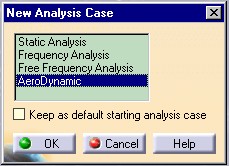 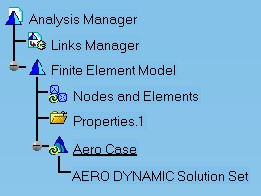 |
CATISamImportDefine
This import command is a contextual menu on the Links Manager object.
|
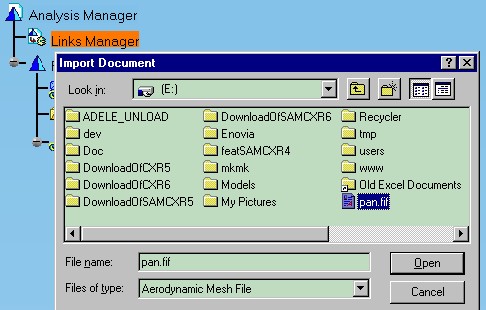 |
CATIPersistent
|
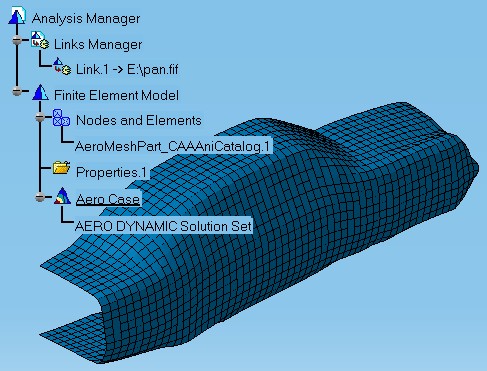 |
CATIMSHMesher
CATISamExplicitation
|
 |
Code for these use case is contained in the CAAAniWB.m, CAAAniCatalog.m and CAAAniAeroDtransition.m modules of the CAAAnalysisInterfaces.edu framework.
The CAAAnalysisInterfaces.edu sample shows how to add a new Analysis feature inside CATIA Analysis Infrastructure.
You can now successively go to:
[Top
| [1] | Feature Modeler |
| [2] | Analysis Modeler |
| [3] | Sample of export |
| [Top] | |
| Version: 1 [Mar 2000] | Document created |
| [Top] | |
Copyright © 2000, Dassault Systèmes. All rights reserved.